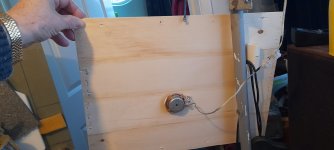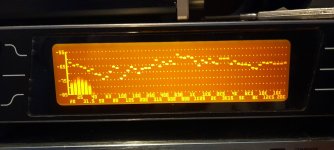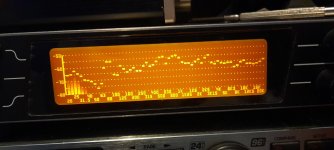There's no doubt that there will be interference. Is interference necessarily bad? Waves reflect off every perimeter of a panel (especially one with free edges) and interfere with the original wave and each other. In fact, the interference of all those reflections is what creates the modes that make a DML a DML. If interference has to be bad, why are free and undamped perimeters (which result in more interference) good?If two coils are on the same panel surface these outward waves will collide , interfering with each other's natural flow.
I suggested watching at 1/4 speed. Is it my fault if you don't do that?Your videos apart from being very fast for some reason ?
It shows exactly what happens, and no more, no less.Does not seem to show much at all ?
And if we would see "the waves move up and down in frequency" (or something that looks like that), why would it indicate a necessarily bad result at normal listening distances?You will just have to wait until I do my video on YouTube, watching me move the microphone around the panel slowly in real time, as the waves move up and down in frequency as the microphone is moved away from and in between the exciters.
Eric
Lawnboy.
The closest panel size i have to the one you mention is 17inches 13 inches I made this from strips of 3mm ply from crates .
The second picture is from 3m into the room I believe and the third is at 1m if I've got them the right way round.
Everything below 50hz is traffic noise and my big feet 😁
The closest panel size i have to the one you mention is 17inches 13 inches I made this from strips of 3mm ply from crates .
The second picture is from 3m into the room I believe and the third is at 1m if I've got them the right way round.
Everything below 50hz is traffic noise and my big feet 😁
Attachments
Lawnboy.
I have made no attempt to improve the sound or performance of this crate ply panel.
all I did was stick on the exciter.
so improvements can be made.
Steve.
I have made no attempt to improve the sound or performance of this crate ply panel.
all I did was stick on the exciter.
so improvements can be made.
Steve.
It is the reason I prefer the sound of one exciter and not two, as I have said before it muddies the water (pun intended ) if you do not care if the problem is there Or not , there seems no point in me showing you it.There's no doubt that there will be interference. Is interference necessarily bad? Waves reflect off every perimeter of a panel (especially one with free edges) and interfere with the original wave and each other. In fact, the interference of all those reflections is what creates the modes that make a DML a DML. If interference has to be bad, why are free and undamped perimeters (which result in more interference) good?
I suggested watching at 1/4 speed. Is it my fault if you don't do that?
It shows exactly what happens, and no more, no less.
And if we would see "the waves move up and down in frequency" (or something that looks like that), why would it indicate a necessarily bad result at normal listening distances?
Eric
I do not know how to change the speed of your recording and like you I can not be bothered to find out.
I will leave it there , believe what you like.
I will carry on trying to help people build great sounding panels, but not necessarily on this forum as YouTube seems to be a much better way of demonstrating panels.
Steve.
Hello Jaxboy,If this is true (which I am not doubting),
Of course more evidences are always welcome
I guess yes, unless there is an other natural mechanism that increase the level. Applying the technique shown by Eric on different panels should learn a lot on this topic.wouldn't it be a good idea to boost the treble of the signal?
This is the richness of the forum... and also part of the challengeI am a neophyte, and have never studied the mechanics of audio, My masters was in human relations.
Christian
We will miss you.I will carry on trying to help people build great sounding panels, but not necessarily on this forum as YouTube seems to be a much better way of demonstrating panels.
Hello SteveHi Christian .
how far the hf travels depends on the panel materials.
my ply panels for instance , the hf will reach 20k all the way to the far corners , but 70 grade EPS will only be about 10k at the edges.
I can now measure this in real time now I am on YouTube , if you wish ?
It seems so much easier.
Steve
Thank you for the proposal. Yes, it would be interesting to increase the knowledge of materials against that. The distance of the edges should be mentioned also
Could you add proplex in those tests?
I will plan to do the same... not this week, I don't have my measurement tool for now.
@Veleric : which material was your test?
Christian
Please don't go. You are my favorite posting person on this site.I will carry on trying to help people build great sounding panels, but not necessarily on this forum as YouTube seems to be a much better way of demonstrating panels.
Why not both? If You Tube offers a wider public and is dedicated for video, the concentration of passionate DIYers at good level is here.I will carry on trying to help people build great sounding panels, but not necessarily on this forum as YouTube seems to be a much better way of demonstrating panels.
Steve.
Please keep us inform here to what you publish there.
Christian
Thanks , I have found similar items in the UK on Amazon.They’re lamps with shelves
I'm looking at the fabric of the lamp and thinking canvas panel type panel.
Maybe using perspex ?
The other half would not even know they were there, hehehe.
Steve.
Last edited:
My girlfriend drives ingenuity, I can do anything, as long as it looks good. I’m similar in fashion.
It’s why, as of currently, my build is a .23cf cabinet with 5.5” long throw woofer and a small fullranger is the direction I’m headed. I can do a panel if it makes me happy though…
Hi Christian.Hello Steve
Thank you for the proposal. Yes, it would be interesting to increase the knowledge of materials against that. The distance of the edges should be mentioned also
Could you add proplex in those tests?
I will plan to do the same... not this week, I don't have my measurement tool for now.
@Veleric : which material was your test?
Christian
The proplex is a very good panel ,but the problem is I cannot find out anything about the round fluted panels on line only square flutes ?
So if it is not available anymore it seems a bit pointless perusing testing ?
Steve.
Hello Colin,
- What size and shape of canvas should be used? For DMLs made using materials such as XPS it seems to be common for them to be close to square, however all the examples of canvas DMLs I've seen have been more rectangular. Is there a reason for this?
Have a look here Github DML page. The first document is a kind of history file. There is a table summarizing some canvas realizations. Extract :
Not sure it was the result of deep design investigation but more obviously copies... Canvas for painting are also mainly easy to find in rectangular shape. The canvas being identical in both directions, a square shape is not a good idea leading to have modes with the same frequency.
My current choice is DAEX25-4FHE. It is 4 ohms. I would have preferred 8 Ohms not because of the amp but because of the cut off frequency due to the inductance with the voice coil inductance. I won't worry about the impedance viewed by the amplifier. About the legs, no experience. What we read here is they are generally cut.I think I've settled on using the DAEX25 exciter, both because of price and because they are 8ohms which means they are above the minimum impedance of the AV receiver I plan to use them with. I've seen some people cut off the legs from these exciters, should I do this?
As for the proportions, there are not so much variants of this design so few experience. In mine, it is rectangular. The variant is to be with real balsa. It works but the others are light plywood. In posts with Spedge, we understood what he thought to have bought balsa was in fact basswood... probably a good choice.What size and shape should the piece of balsa between the exciter and the canvas be? I've seen both small circular pieces and larger rectangular pieces being used, does it matter?
My dream also when I started to build DML... I am afraid there is no real hope on this way. The rear wave has the same energy as the front one so very difficult to absorb it. Depending of the damping material, some energy will be reflected and combined with the front. Easy to test. Let us know your results... just don't start with a permanent attach method!Can I mount the back of spine directly to a wall, and should I have some sort of damping material (melamine sponges?) between the wall and the canvas?
Same, low deviation from the original one... The canvas is probably not working on exactly the same physics as DML (vibration in a membrane versus in a plate), the common point is modes; Being at the centre, the force coming from the canvas tension is balanced in a better way for the voice coil.It seems like with the canvas panels the exciter is usually mounted at the centre instead of the 2/5 3/5 position. Why?
My experience in EQing is to low to understand really your question. DML are suitable for EQing as they are based on modes. Due to the possible dispersion between panels (material, tension, exciter placement) some individual EQ could make sense. As first step, I would build them and then test them with REW each being at the same location to evaluate the similarities or differences.I plan on eventually using these panels to setup a 5.1 system. In terms of EQing the speakers, I was thinking of connecting them all to my AV receiver and then that to my PC, and then using a calibration mic and room eq wizard. Does this make sense? Maybe this is a dumb question, but is doing this any different from EQing the panels individually?
Christian
Hello Steve,Hi Christian.
The proplex is a very good panel ,but the problem is I cannot find out anything about the round fluted panels on line only square flutes ?
So if it is not available anymore it seems a bit pointless perusing testing ?
Steve.
It would be even a good reason to do it! As you got a material with good results, even if not available, why not trying to figure out more of its characteristics. to help for the next choices.
Christian
A shame about the dome non-test then SteveI will carry on trying to help people build great sounding panels,
Well, they are both pretty clear that they are discussing multi exciters in the context of WFS. The title on the second paper is even "Analysis and Enhancement of Multiactuator Panels for Wave Field Synthesis".That isn't as I read it. He was using digital filters to smooth the response measured with a swept frequency. This however isn't the same as playing say music that contains a whole load of frequencies however he did listening tests. There are other similar papers. Once commercial use thought is using projection screens as a speaker.
- Home
- Loudspeakers
- Full Range
- A Study of DMLs as a Full Range Speaker


